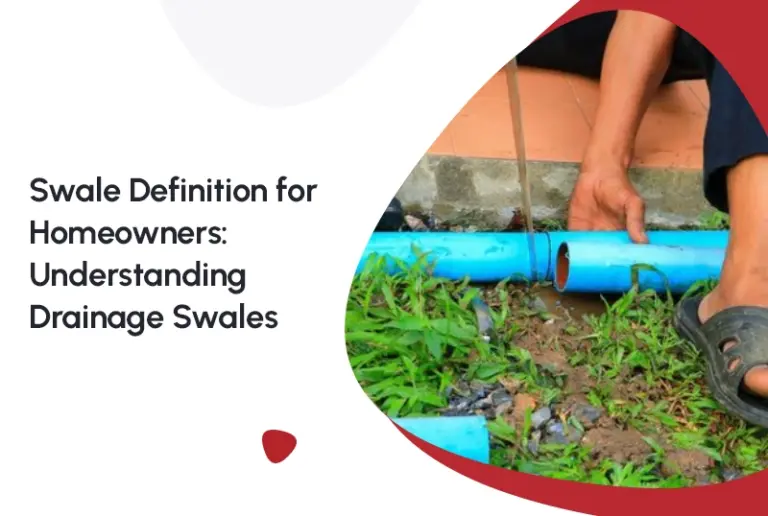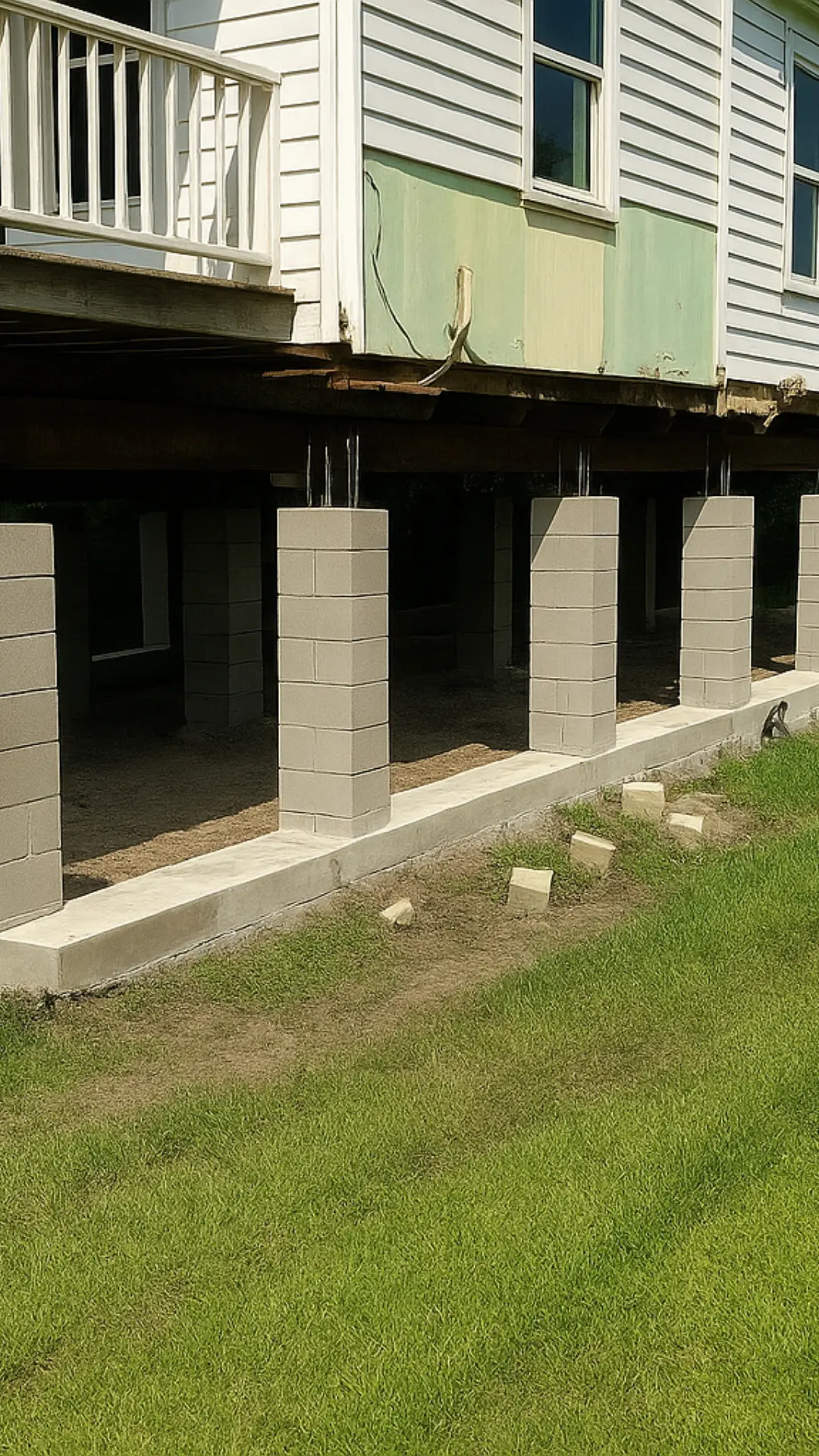Most homeowners think rain gutters exist just to keep water from dripping on their heads during a storm but your drain rain gutter system is actually one of the most important defenses your home has. It protects your foundation, prevents soil erosion, stops basement leaks, keeps crawl spaces dry, and even prevents long-term structural problems that can cost thousands to repair.
Picture this: a heavy Texas storm rolls in. The rain pours off your roof, gushes down the sides of your house, pools at the base, and slowly starts sinking into the soil softening it, shifting it, and putting pressure on your foundation. Over time, this leads to cracks, uneven floors, settlement, and a whole list of headaches nobody wants.
A proper drain rain gutter system prevents all of that by guiding water away safely before it becomes a threat.
Today, we’ll break down exactly how it works, why it matters, what happens when drain rain gutter fail, and why drainage is a HUGE deal for homes built on clay-heavy soil especially in areas like Spring, Texas. We’ll also connect you with solutions such as foundation repair Spring, house leveling Spring, and pier and beam foundation repair Spring for homeowners dealing with water-related damage.
Let’s dive in.
Why Gutters Exist: The Real Purpose of a Drain Rain Gutter System
Drain rain gutter do much more than catch water. Their job is to:
- Funnel water from the roof
- Direct it through downspouts
- Carry it safely away from your home’s foundation
- Prevent soil oversaturation
- Reduce hydrostatic pressure
- Stop erosion and ground shifting
Without gutters, your house becomes a giant waterfall every time it rains.
A good drain rain gutter setup ensures rainwater goes where you want, not where gravity wants.
When you think about the volume of water your roof sends to the ground, the numbers get scary: research shows that every inch of rain on a 2,500 ft² roof deposits around 1,500 gallons onto the ground around your home. Gutters must capture and redirect that water or your foundation will take the hit.

How Gutters Protect Your Foundation
Your foundation is the backbone of your home. If it shifts, cracks, or settles, everything above it feels the impact—floors tilt, windows jam, doors won’t close, and walls crack.
A proper drain rain gutter system protects your foundation in four major ways:
1. Gutters Prevent Soil Erosion
When rainwater falls directly around the perimeter of your home, it washes away soil little by little. Over months and years, this creates voids under your foundation.
This leads to:
- Foundation sinking
- Uneven floors
- Gaps between walls and ceilings
- Cracked brick
- Slab separation
This is one of the main reasons homeowners end up needing house leveling service Spring.
2. Gutters Reduce Hydrostatic Pressure
When water soaks the soil around your foundation, the pressure builds. This is called hydrostatic pressure, and it pushes against your home’s foundation walls.
Too much pressure = cracks.
The Federal Emergency Management Agency (FEMA) reports that excess groundwater is one of the top causes of structural foundation damage nationwide.
Proper drainage reduces this pressure significantly.
3. Gutters Prevent Foundation Cracks
Excess moisture expands clay soil, while heat shrinks it. This back-and-forth movement causes slab foundations to shift and crack.
A functional drain rain gutter reduces water infiltration so the soil stays at a more stable moisture level.
4. Gutters Protect Crawl Spaces and Pier-and-Beam Homes
Homes with crawl spaces rely heavily on dry soil conditions. Moisture can cause:
- Mold growth
- Wood rot
- Sagging floors
- Beam weakening
- Pier shifting
When moisture problems get severe, homeowners turn to pier and beam foundation repair Spring for help.
What Happens When Gutters Fail?
When drain rain gutters become clogged, overflow, or discharge water too close to your home, the effects often show up gradually but the damage can be extensive. Without proper drainage, rainwater ends up where it shouldn’t, leading to a chain reaction of structural and moisture-related problems.
Here’s what typically happens:
Cracks in walls
Excess moisture around the foundation causes soil to expand and contract, creating pressure that transfers into the structure and leads to interior and exterior wall cracks.
Gaps around windows and doors
As the foundation shifts even slightly, framing becomes misaligned, producing visible gaps that let in drafts, pests, and water.
Pooled water near the slab
Water that’s not redirected away accumulates along the perimeter of the home, saturating the soil and increasing the likelihood of slab settlement.
Musty or moldy odors in crawl spaces
Excess moisture encourages mold growth and wood rot, especially in enclosed spaces with limited airflow.
Standing water in the yard
Overflowing drain rain gutters dump concentrated water into the landscape, causing soggy soil, muddy patches, and poor lawn health.
Damage to plants and landscaping
Too much water can drown plant roots, erode mulch beds, wash out soil, and destroy carefully planned landscaping features.
Basement leaks or dampness
Water pooling against the home can seep through basement walls or floors, leading to dampness, staining, or full-blown leaks.
Foundation movement
Persistent water exposure weakens the soil supporting your home. Over time, this can cause settling, shifting, or uneven foundation movement—one of the costliest and most serious consequences of poor gutter drainage.
The American Society of Home Inspectors found that over 35% of foundation issues are linked directly to improper drainage or gutter failures.
Water may look harmless, but when it attacks your foundation, it is expensive.
Why Weather Makes Gutters Even More Important
Texas weather creates conditions that make proper drainage essential, especially in areas like Spring, where soil movement is common.
1. Highly Reactive Clay Soil
Much of Texas sits on expansive clay, a type of soil that dramatically changes volume depending on moisture levels:
- When wet: it swells and exerts upward pressure on the foundation.
- When dry: it contracts, creating voids that allow the foundation to settle or shift.
This constant cycle of expansion and contraction puts continuous stress on your home.
2. Weather Extremes Intensify the Problem
Texas frequently experiences heavy rain followed by long periods of heat. These rapid moisture swings cause the soil to move even more aggressively, increasing the likelihood of cracks, uneven floors, and foundation damage.
3. Gutters Help Stabilize the Soil
A properly designed drain rain gutter system directs water away from the foundation, reducing the dramatic wet–dry cycles that cause clay soil to move. By controlling where water flows, gutters help maintain a more consistent moisture level, which keeps the soil and your foundation far more stable.
How a Drain Rain Gutter System Actually Works
Let’s break down each component:
1. The Gutter Itself
Collects water along the roofline.
If clogged → it overflows → water falls directly next to your home.
2. Downspouts
These guide water from the roof to the ground.
Downspouts should extend:
- 6 feet away from your house (minimum)
- 10 feet in clay-heavy areas like Spring
3. Splash Blocks or Extensions
These help redirect water farther away so it doesn’t erode the soil.
4. Underground Drain Lines
These are optional but powerful.
They move water underground and release it far from the foundation.
But you must maintain them—they clog easily.
5. Grading
Your yard needs a slight slope away from the foundation.
Without proper grading → drain rain gutters become almost useless.
Signs Your Drain rain Gutter System Is Failing
Here’s what to watch out for:
- Soil washed away near the home
- Gutters overflowing during rain
- Water stains on siding
- Mud splashed on the foundation
- Pooling water around the perimeter
- Cracks growing larger after heavy rain
- Sagging or uneven floors (related to foundation issues)
If you notice any of these, your foundation may already be compromised—time to look into foundation repair Spring for an inspection.
How Gutters and Home Foundations Work Together
Think of gutters as your home’s first drainage system.
The soil, grading, underground drains, and landscaping are the second.
Your foundation is the final line of defense.
When the first line fails → the last line suffers.
This is why homeowners who ignore drain rain gutter problems often end up needing major foundation work, including:
- Soil stabilization
- Concrete underpinning
- Pier installation
- Beam replacement
- House leveling service Spring
- Pier and beam foundation repair Spring
Good drain rain gutters = fewer repairs.
How to Maintain Your Drain Rain Gutter System
Follow this quick guide to keep your gutters functioning:
Clean gutters twice a year
Spring and fall are ideal.
Install gutter guards
Helps prevent leaves and debris.
Extend downspouts
At least 6–10 feet away.
Check for leaks
Seal joints with gutter caulk.
Inspect grading
Soil should slope AWAY from the house.
Watch for overflow during storms
If it overflows, it needs cleaning or repair.
Clear underground drains
Use a plumber’s snake if necessary.
Why Gutters Alone Aren’t Enough (But Still Essential)
A drain rain gutter system is just one piece of the foundation protection puzzle.
You must also maintain:
- Yard grading
- Soil moisture levels
- Drainage paths
- Crawl space ventilation
If your foundation has already started moving, gutters won’t fix it—you’ll need professional help.
This is where services such as foundation repair Spring, house leveling Spring, and pier and beam foundation repair Spring come in.
Frequently Asked Questions (FAQs)
1. How do you drain water away from gutters?
Extend downspouts at least 6–10 feet away from your foundation. Use splash blocks, flexible extensions, or underground drainage pipes. Ensure your yard slopes away from the house for proper flow.
2. How deep should a rain gutter underground drain be?
Typically 6–12 inches deep, but in areas with freezing temperatures, it should be at least 12–18 inches to avoid freezing. In clay soil (like Spring), deeper installation prevents clogs.
3. What are the rules for gutter drainage?
General rules include:
- Direct water away from the foundation
- Do not drain onto neighboring property
- Extend the discharge point several feet away
- Ensure the flow follows the natural grade
Local regulations may vary.
4. What is the problem with buried downspouts?
They clog easily with leaves, dirt, and mud. If not maintained, they can back up and overflow—dumping water right next to the foundation instead of away from it.
5. Are underground gutter drains worth it?
Yes when maintained. They hide drain lines, keep yards clean, and move large amounts of water far from the foundation. Ideal for flood-prone areas like Spring.
6. Where should gutters drain to?
The goal: a safe discharge point at least 6–10 feet from the foundation. Options include:
- Dry wells
- Drainage ditches
- Sloped lawns
- French drains
- Underground drain fields
7. How do you fix a leaking gutter pipe?
Use silicone sealant or gutter caulk to patch holes, tighten loose sections, or replace damaged areas. For underground pipes, clear blockages with a snake or pressure washer.






